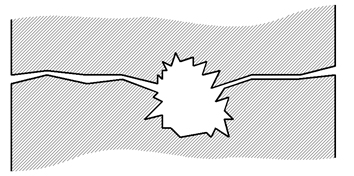Tricky Leaks
Different types of leaks behave differently. This can make leak detection tricky, unless you understand the reasons for what you experience. The geometry of the leak, the pressure, material, humidity, temperature and flow are all factors that influence the behavior of a leak. In the last issue of LEAK TEST, we focused on the weather dependent and on the disappearing refrigerant leak. In this issue we will look at three more examples of tricky leaks.
Type #1: The jet-stream leak
When using tracer gas for leak locating, you may sometimes find yourself in a situation where you can only locate leaking tracer gas in a very narrow area. At the same time, you get leak indications far away from the test object (several feet / decimeters) for no obvious reason. What you may have found is a leak that is very narrow and sends out a thin stream of tracer gas at a high speed. Almost the same as when a laser pointer sends out a narrow beam. The cone of the stream will get larger the further way from the leak the stream is, but may still be rather narrow a fair distance away from the leak. The stream of gas may first hit the operator or surrounding structures and “bounce” and cause confusion as to where the origin of the stream is. Being aware of this tricky leak may save valuable testing time.
Type #2: Cast aluminum leaks
Casted aluminum objects may contain pores caused by gas trapped during the solidification of the melted metal. Such pores may be very large and obvious to the eye or so small that they do not cause much of a problem. Pores can be totally enclosed within the part with no opening to the surface, or open to either or both surfaces. The latter will form a leak path through the object.
Leaks in cast objects can be pinhole shaped which can act as a fine tube through the object. These leaks behave quite predictably. A leak can also appear as an area of porous material. This is often a high number of very small leaks resulting in a larger total leakage. If the area is spread out it can be difficult to detect the leakage with a sniffer that cannot catch the entire leak flow.

The "penetrating leak" is a tricky form of leak in cast objects
The trickiest form of leak in cast metal is the penetrating leak that connects to a hidden larger cavity that acts as a gas reservoir during leak test. This structure can cause considerable delay between gas injection and gas penetration to the opposite side of the leak.
Semi-hidden and totally enclosed leaks can also be tricky if the leak test is performed on the “as cast” object and if there is some post leak test machining that opens up such enclosed leak pores.
Micropores can also be closed by various liquids used in processing, or by paint, etc. Such effects should be carefully considered when deciding where to place leak detection in the production process flow. Generally it is advisable to check for leaks after any machining and pickling processes, but before surface treatments such as painting or electrochemical plating or oxidization.
Type #3: The invisible liquid leak
Leak testing an object with liquids may show a non-leaking product, but tracer gas leak testing reliably finds liquid size leaks. A leak that can carry liquids to the surface may simply do so very slowly so that when the liquid reaches the surface of the outside of the object, the liquid evaporates. It evaporates at a speed that leaves no stain or marks visible at the leak exit.
Do you have an application you would like to discuss with our leak detection experts? Have you also experienced some tricky leaks? Contact INFICON and tell us! Maybe your case will make it into a future issue of this newsletter.